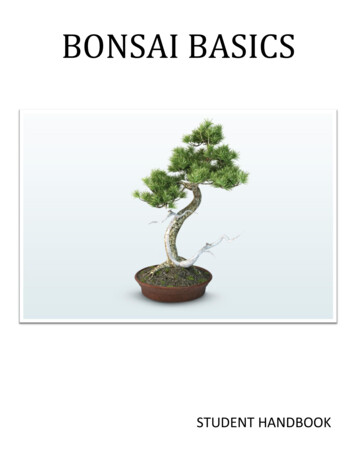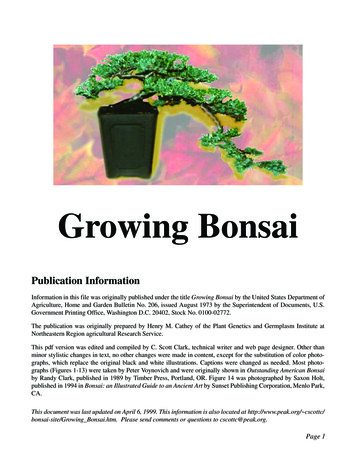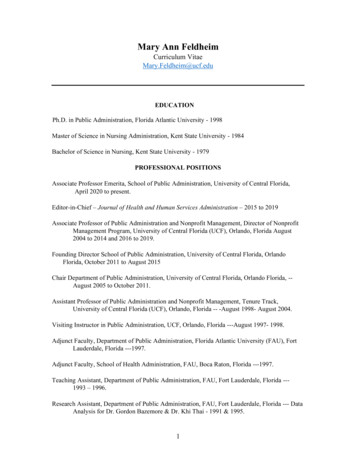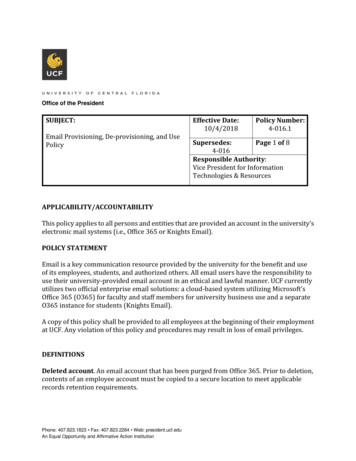
Transcription
BONSAI BASICSSTUDENT HANDBOOK
Table of ContentsObjective1Introduction2History3What makes good bonsai5Rules of bonsai6Sunlight9Fertilizer10Watering14Insects & Disease15Moss Basics20Bonsai Soil22Trees 10126Growth Principles29The Front31Care of your tree (Before)34Care of your tree (After)35Wiring36Basic Proportions48Basic Design49Pots50Tools53Glossary of terms54
OBJECTIVEThis workbook was designed to aid the aspiring Bonsai artist by providing an overview ofthe many topics associated with Bonsai Basics. Most of the information included in thisworkbook was obtained from several online sources and has been reviewed to assure itsaccuracy.Along with the information from a qualified Bonsai artist, this handbook’s materialforms a detailed compilation of valuable facts and guidelines which will assist the aspiringartist in the growing and training of Bonsai.1
INTRODUCTIONBonsai (盆栽, "tray planting") is a Japanese art form using trees grown in containers.Similar practices exist in other cultures, including the Chinese traditionof penjing from which the art originated. Japanese tradition dates back over athousand years. "Bonsai" is a Japanese pronunciation of the earlier Chineseterm penzai. The purposes of bonsai are primarily contemplation (for the viewer) andthe pleasant exercise of effort and ingenuity (for the grower), by contrast with otherplant cultivation practices, bonsai is not intended for production of food or formedicine. Instead, bonsai practice focuses on long-term cultivation and shaping ofone or more small trees growing in a container.A bonsai is created beginning with a specimen of source material. This may be acutting, seedling, or small tree of a species suitable for bonsai development. Bonsaican be created from nearly any perennial woody-stemmed tree or shrub species thatproduces true branches and can be cultivated to remain small through potconfinement with crown and root pruning. Some species are popular as bonsaimaterial because they have characteristics, such as small leaves or needles that makethem appropriate for the compact visual scope of bonsai.The source specimen is shaped to be relatively small and to meet the aestheticstandards of bonsai. When the candidate bonsai nears its planned final size it isplanted in a display pot, usually one designed for bonsai display in one of afew accepted shapes and proportions. From that point forward, its growth isrestricted by the pot environment. Throughout the year, the bonsai is shaped to limitgrowth, redistribute foliar vigor to areas requiring further development, and meetthe artist's detailed design.The practice of bonsai is sometimes confused with dwarfing, but dwarfing generallyrefers to research, discovery, or creation of plant cultivars that are permanent,genetic miniatures of existing species. Bonsai does not require genetically dwarfedtrees, but rather depends on growing small trees from regular stock and seeds.Bonsai uses cultivation techniques like pruning, root reduction, potting, defoliation,and grafting to produce small trees that mimic the shape and style of mature, full-sizetrees.2
HISTORYWhile the art of bonsai has long been associated with Japan, itactually originated first in China, and then spread eastward to Korea andthen Japan. The art of bonsai was spread by Buddhist monks who wishedto bring the “outdoors” inside their temples. From ancient paintings andmanuscripts, we know that “artistic” container trees were being cultivatedby the Chinese around 600 AD, but many scholars feel that bonsai, or atleast potted trees, were being grown in China as far back as 500 or 1,000BC. Bonsai first appeared in Japan during the 12th century.It is no accident that artistic plant cultivation originated in China.The Chinese have always loved flowers and plants, and the country isnaturally endowed with a rich diversity of flora. The Chinese also had apassion for gardens. In fact, many of these gardens were on a miniaturescale and included many miniature trees and shrubs, planted to reinforcethe scale and balance of their landscapes. The Chinese, however, were alsoinfatuated in miniaturization as a science in its own right. They believedthat miniature objects had concentrated within them certain mystical andmagical powers.The development of Chinese and Korean ceramics played animportant role in the development of bonsai as we know it today. Withoutthe development of beautiful Chinese containers, bonsai trees would nothave been admired as much as they have been. Bonsai literally means“tree in a tray.” The tree and container must form a single entity. Even tothis day the most desired containers for the finest Japanese bonsai areoften antique Chinese containers.Bonsai has evolved and developed along different lines in China andJapan. Chinese bonsai is still very much in the ancient tradition, and oftenappear “crude” to the uninformed. On the other hand, the Japanese stylesare more pleasing and naturalistic. The Japanese trees are for the mostpart more refined and better groomed. Both types have their ownindividualistic charms and admirers.3
In the post-World War II era most of the bonsai seen in the UnitedStates and Europe are Japanese in origin. The monopoly that Japan hasenjoyed until recently is coming to be shared with a number of othercountries, although the quality of Japanese trees continues to be of thehighest quality.Finally, we owe a great debt to the Japanese and Chinese artists fordeveloping this beautiful art and for keeping it alive for almost 2,500years. Without their enthusiasm, artistic tradition, and patientstewardship, we would not be enjoying bonsai as we know it today. Theaesthetic sensibilities of bonsai, which have their roots in the Zen Buddhisttradition, contribute significantly to the complete bonsai experience.4
WHAT MAKES GOOD BONSAI1. Signs of good health and stability such as leaf color and wellsettled, natural looking moss. No signs of carelessness and abusesuch as badly healed pruning scars or scars from wire left on toolong.2. A strong well shaped trunk springing naturally from the soil andmoving upwards towards the apex in an even taper.3. A good fanning out of surface roots (nebari) from the base of thetrunk gradually disappearing into the soil.4. A good, well-proportioned head of branches which are well spacedand appear to spring naturally from the trunk or from largerbranches.5. The tree is as natural looking as possible considering its species,style, and size.6. The pot must be in proportion to the tree to form an artistic unity.7. The tree should be placed in the pot so as to create a visualbalance8. Flowers, fruit, and leaves must be in proportion.9. A tree growing with its roots clasping a rock must really adhere tothe rock, not just wrap around it.10. A tree should be planted well raised in its pot so that the bole canbe clearly seen over the rim of the pot when viewed at eye level.11. Stones, moss or other covering on the surface of the soil moknatural and in scale.5
RULES OF BONSAITrunk and Nebari RulesHeight should be six times the caliper of the trunk.Trunk should lean slightly toward the viewer.Trunk should flare at base to visually anchor the plant.Roots should radiate from the flare.No eye-poking roots (directly at viewer).Apex should lean toward viewer.Trunk should taper as it ascends. No reverse taper.Grafts should match under stock and scion so that they are unobtrusive, or beplaced low enough to disappear into the nebari.Curves in trunk should not result in 'pigeon breast' (roundness toward viewer).Apex should finish in the direction set by the base. 'Flow' should be maintained.Trunk line should not move 'back on itself'. It relates to the flow of the tree. Atrunk line that moves back on itself creates a 'C' curve.For formal and informal upright, the apex should be over the base.In informal uprights, too many 'S' curves will be tiresome.As a tree ascends the curves should be closer together (related to branchplacement).A tree should have only one apex.6
Twin tree trunks should divide at the base, not higher up.BranchesNo crossing branches or branches that cross the trunk.No eye-poking branches (pointed directly at viewer).First branch should be placed approximately 1/3 the height of the tree.Succeeding branches placed at 1/3 the remaining distance to the top of the tree.Branches go on the outside of the curves (No belly branches).Branch caliper should be in proportion to the trunk. Branches that are thicker than1/3 the trunk caliper will be too thick.First branch should be left (or right), second branch right (or left), third branchshould be back branch.Branches should visually alternate, no parallel branches.Branches should diminish in size and caliper as they ascend.There should be space between the branches to 'Let the birds fly through'.First and second branches (Left and Right branches) should be placed forward ofthe mid line to 'invite' the viewer.First, second, and third branches are approximate 120 degrees apart, with the backbranch not directly behind the tree.Only one branch per trunk position, no 'wheel and spoke' or whorled branches, orbar branches (branches directly opposite each other).Branches should create an outline of a scalene triangle with the apex representingGod, the middle corner man and the lower corner earth.Secondary branches should alternate left and right and follow the rules of mainbranch placement, except there should be no secondary branches moving up ordown. This creates the foliage pad.To create the illusion of an old tree, wire the branches down. Young trees haveascending branches. The branches near and in the apex can be horizontal orascend since this is the young part of the tree.Branches for cascades generally follow the rules for uprights, except that the trunkmoves down.7
In twin trees, there should not be branches between the trees which would crossthe trunks. The outside branches of both trees create the triangle of foliage.A jin should not be hidden in foliage.PotsThe tree should be placed behind the mid line of the pot, and to the left or right ofthe center line.The depth of the pot should be the caliper of the trunk, except for cascades.Colored glazed pots should be used for flowering and fruiting trees and the colorsshould complement the flower color.The width of the pot should be 2/3 the height of the tree. For very short trees, thewidth should be two thirds the spread of the tree.Style of the pot should match the tree. Uprights without much movement shouldbe in rectangular pots, informal uprights with a lot of trunk movement should bein oval or round pots. Massive trees should be in deep rectangular pots.CultureSoils should be uniform, not layered.Fertilize full strength.Water from above not by submerging; this will prevent the buildup of salts.Increase humidity by using a tray of pebbles and water or by keeping the areaunder the bench wet, not by misting.Remove most of the 'fines' from any soil mix, using only coarse particles.Water when the plants need to be watered, not by a fixed schedule.Keep temperate climate plants outside. Only tropical and subtropical plants (forthe most part) are suitable for indoor bonsai. Temperate climate plants must begiven an appropriate period of cold dormancy if they are to be kept indoors.8
SUNLIGHTPhotosynthesis is a process used by plants to convert light energy into chemicalenergy that can later be released to fuel the plant's activities. This chemical energy is storedin carbohydrate molecules, such as sugars, which are synthesized from carbondioxide and water – hence the name photosynthesis. In most cases, oxygen is also released asa waste product. Although photosynthesis is performed differently by different species, theprocess always begins when energy from light is absorbed by proteins called reactioncenters that contain green chlorophyll pigments. In plants, these proteins are heldinside organelles called chloroplasts, which are most abundant in leaf cells. In these lightdependent reactions, some energy is used to strip electrons from suitable substances, such aswater, producing oxygen gas. In plants, algae and cyanobacteria, long-term energy storage inthe form of sugars is produced by a subsequent sequence of light-independent reactionscalled the Calvin cycle.Sunlight, especially the ultra-violet ray, affects the growth of trees. Therefore, except inspecial cases such as immediately after repotting, extensive trimming, etc., bonsai should beplaced in a sunny location. Bright light will also work well but the tree should not be placedmore than 12" away from the direct light source.An east, west or southern exposure works best. A northern exposure will require the useof "grow lights" which should remain on up to 16 hours each day and the lamp should not bemore than 2 inches from the top of the tree. Incandescent light is too hot and will not providethe various spectrum of light that is required to maintain your bonsai tree.Bonsai need about 5 hours of direct or indirect sunlight per day. Certain species ofbonsai do best in the winter if they receive most of their light from indirect sources. Bonsaitrees can burn if taken from a shady location to a sunny location so care should be taken togradually increase their light exposure.If you do not have a window or light source that provides an east, west or southernexposure, be sure to select a bonsai tree that does well in lower lighting conditions.NOTE: Remember to turn your trees frequently so that they receive light equally on allsides; otherwise, they will grow lopsided and limbs kept on the shady side may eventually die.9
FERTILIZERQ: Is fertilizer plant food?It is not. Fertilizer is a substance that contains plant nutrients that are added to theenvironment around a plant. Usually, fertilizer is added to soil or water, but somefertilizers can also be sprayed directly onto plant leaves, or into the air. Although it iscommon for many
Bonsai uses cultivation techniques like pruning, root reduction, potting, defoliation, and grafting to produce small trees that mimic the shape and style of mature, full-size trees. INTRODUCTION . 3 While the art of bonsai has long been associated with Japan, it actually originated first in China, and then spread eastward to Korea and then Japan. The art of bonsai was spread by Buddhist monks .











